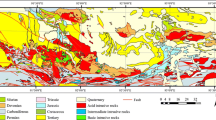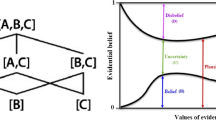Abstract
Selection of potential areas for mineral exploration is a complex process and needs many diverse criteria. Combining analytic hierarchy process (AHP) modeling with geographic information system (GIS) provides an effective means for studies of mineral potential mapping evaluation. Fuzzy AHP is an extension of conventional AHP and by using fuzzy theory is obtained the advantage rather AHP method. In this paper to provide, potential mapping for Cu porphyry mineralization used fuzzy AHP and GIS in the Ahar–Arasbaran areas, several criteria, such as geology, geochemical and geophysical data, alteration, and faults were used. Each criterion was evaluated with the aid of fuzzy AHP and mapped by GIS. The method allowed a mixture of quantitative and qualitative information with group decision. The results and its validation demonstrate the acceptable outcomes for copper porphyry exploration.




Similar content being viewed by others
References
Albayrak E, Erensal YC (2004) Using analytic hierarchy process (AHP) to improve human performance: an application of multiple criteria decision making problem. J Int Manufact 15:491–503
Alianvari A, Katibeh H, Sharifzadeh M (2012) Application of fuzzy Delphi AHP method for the estimation and classification of Ghomrud tunnel from groundwater flow hazard. Arabian J Geosci 5:275–284
Amini B (1994) Geological map of Iran 1:100,000 series—Meshkinshahr. Geological Survey of Iran
Asadian O (1993) Geological map of Iran 1:100,000 series—Tabriz. Geological Survey of Iran
Asadian O, Mirzaee A, Mohajjel M, Hadjialilu B (1994) Geological map of Iran 1:100,000 series—Marand. Geological Survey of Iran
Azizi H, Tarverdi MA, Akbarpour A (2010) Extraction of hydrothermal alterations from ASTER SWIR data from east Zanjan, northern Iran. Advanc Space Res 46:99–109
Babaie HA, Ghazi AM, Babaei A, La Tour TE, Hassanipak AA (2001) Geochemistry of arc volcanic rocks of the Zagros crush zone, Neyriz, Iran. J Asian Earth Sci 19:61–76
Babakhani A, Nazer N (1991) Geological map of Iran 1:100,000 series—Lahrood. Geological Survey of Iran
Berberian M, King GC (1981) Towards a paleogeography and tectonic evolution of Iran. Canadian J Earth Sci 18:210–265
Binbin H, Cuihua C, Yue L (2010) Gold resources potential assessment in Eastern Kunlun Mountains of China combining weights-of-evidence model with GIS spatial analysis technique. Chin GeograSci 20(5):461–470
Carranza EJM (2004) Weights of evidence modeling of mineral potential: a case study using small number of prospects, Abra, Philippines. Nat Resour Res 13:173–187
Carranza EJM (2008) Geochemical anomaly and mineral prospectivity mapping in GIS. Handbook of exploration and environmental geochemistry, vol 11. Elsevier, Amsterdam
Carranza EJM, Hale M (2002) Spatial association of mineral occurrences and curvilinear features. Math Geol 34:203–221
Carranza EJM, Van Ruitenbeek FJA, Hecker C, van der Meijde M, van der Meer FD (2008) Knowledge-guided data-driven evidential belief modeling of mineral prospectivity in Cabo de Gata, SE Spain. Int J App Earth Observ Geoinf 10:374–387
Chandio IA, Matori ANB, Yusof KBW, Talpur MAH, Balogun AL, Lawal DU (2012) GIS-based analytic hierarchy process as a multicriteria decision analysis instrument: a review. Arabian J Geosci. doi:10.1007/s12517-012-0568-8
Chang CW, Wu CR, Lin CT, Chen HC (2008) Evaluating and controlling silicon wafer slicing quality using fuzzy analytical hierarchy and sensitivity analysis. Int J Adv Manuf Technol 36:322–333
Chen MF, Tzeng GH, Ding CG (2008) Combining fuzzy AHP with MDS in identifying the preference similarity of alternatives. Appl Soft Comput 8:110–117
Coolbaugh MF, Raines GL, Zehner RE (2007) Assessment of exploration bias in data-driven predictive models and the estimation of undiscovered resources. Natural Res Res 16(2):199–207
Dagdeviren M, Yavuz S, Kilinc N (2009) Weapon selection using the AHP and TOPSIS methods under fuzzy environment. Expert Syst Appl 36:8143–8151
Daneshfar B (1997) An evaluation of indicators of prospectivity and potential mapping of porphyry deposits in middle and southern British Columbia by a GIS study of regional geochemical and other geoscientific data. Ph.D. thesis, University of Ottawa, Canada
De Araujo CC, Macedo AB (2001) Multicriteria geologic data analysis for mineral favorability mapping: application to a metal sulphide mineralized area, Ribeira Valley Metallogenic Province, Brazil. Natural Res Res 11(1):29–43
Ertugrul I, Karakasoglu N (2008) Comparison of fuzzy AHP and fuzzy TOPSIS methods for facility location selection. Int J Adv Manuf Technol 39:783–795
Faridi M, Haghfarshi E (2006) Geological map of Iran 1:100,000 series—khajeh. Geological Survey of Iran
Gumus AT (2009) Evaluation of hazardous waste transportation firms by using a two step fuzzy-AHP and TOPSIS methodology. Expert Syst App 36:4067–4074
Hezarkhani A (2006) Petrology of the intrusive rocks within the Sungun porphyry copper deposit, Azerbaijan, Iran. J Asian Earth Sci 27:326–340
Hezarkhani A (2008) Hydrothermal evolution in Sonajil porphyry copper system (East Azarbaijan Province, Iran): the history of an uneconomic deposit. Journal of IGR, Stanford, USA 50:483–500
Hezarkhani A, Williams-Jones AE (1996) Physico-chemical controls of alteration and mineralization at the Sungun porphyry copper deposit, Iran. In: Geological Association Canada—Mineralogical Association Canada (GAC-MAC) Annual Meeting (vol. 21, p. A-44), Winnipeg
Hezarkhani A, Williams-Jones AE, Gammons C (1997) Copper solubility and deposition conditions in the potassic and phyllic alteration zones, at the Sungun porphyry copper deposit, Iran. In Geological Association Canada—Mineralogical Association Canada (GAC-MAC) Annual Meeting, vol. 50, p. A-67, Ottawa
Hezarkhani A, Williams-Jones AE (1998) Controls of alteration and mineralization in the Sungun porphyry copper deposit, Iran: evidence from fluid inclusions and stable isotopes. Econ Geol 93:651–670
Hezarkhani A, Williams-Jones AE, Gammons CH (1999) Factors controlling copper solubility and chalcopyrite deposition in the Sungun porphyry copper deposit, Iran. Mineralium Deposita 34:770–783
Hongjin J, Daoming Z, Yanxiang S, Yangang W, Xisheng W (2007) Semi-hierarchical correspondence cluster analysis and regional geochemical pattern recognition. J Geochem Explor 93:109–119
KarimzadehSomarin A (2005) Petrology and geochemistry of Early Tertiary volcanism of the Mendejin area, Iran, and implications for magma genesis and tectonomagmatic setting. Geodin Acta 18:343–362
Leite EP, Filho CRDS (2009) Probabilistic neural networks applied to mineral potential mapping for platinum group elements in the Serra Leste region, Caraja’s Mineral Province, Brazil. Comput Geosci 35:675–687
Mahdavi MA, AminiFazl A (1988) Geological map of Iran 1:100,000 series—Ahar. Geological Survey of Iran
Mehrpartou M, Aminifazl A, Radfar J (1992) Geological map of Iran 1:100,000 series—Varzeghan. Geological Survey of Iran
Mehrpartou M (1997) Geological map of Iran 1:100,000 series—Siahrood. Geological Survey of Iran
Mehrpartou M (1999) Geological map of Iran 1:100,000 series—Kaleybar. Geological Survey of Iran
Minatour Y, Khazaei J, Ataei M (2012) Earth dam site selection using the analytic hierarchy process (AHP): a case study in the west of Iran. Arabian J Geosci. doi:10.1007/s12517-012-0602-x
Mohajjel M, Fergusson CL (2000) Dextral transpression in Late Cretaceous continental collision, Sanandaj–Sirjan zone, western Iran. J Struct Geol 22:1125–1139
Mollai H, Dave VKS, Sharma R (2004) Copper mineralization at Mazraeh North West of Iran: evidences for fluid evolution and skarn deposit. Abstract volume of 32nd International Geological Congress, Florence, August 20–28, 2004, p. 223
Mollai H, Sharma R, Pe-Piper G (2009) Copper mineralization around the Ahar Batholith, north of Ahar (NW Iran): evidence for fluid evolution and the origin of the skarn ore deposit. Ore Geology Reviews 35:401–414
Nabavi M (1976) An introduction to the geology of Iran. Geological Survey of Iran Publication, 109 pp (in Persian)
Onut S, Soner S (2008) Transshipment site selection using the AHP and TOPSIS approaches under fuzzy environment. Waste Manage 28:1552–1559
Pazand K, Hezarkhani A, Ataei M, Ghanbari Y (2011) Combining AHP with GIS for predictive Cu porphyry potential mapping: a case study in Ahar Area (NW, Iran). Natural Res Res 20(4):251–262
Pourhosseini F (1981) Petrogenesis of Iranian plutons: a study of the Natanz and Bazman intrusive complexes. Ph.D. thesis. University of Cambridge; also Geological Survey of Iran, report no. 53
Porwal A, Carranza EJM, Hale M (2003a) Artificial neural networks for mineral-potential mapping: a case study from Aravalli province, western India. Nat Resour Res 12:155–171
Porwal A, Carranza EJM, Hale M (2003b) Knowledge-driven and data-driven fuzzy models for predictive mineral potential mapping. Nat Resour Res 12:1–25
Porwal A, Carranza EJM, Hale M (2004) A hybrid neuro-fuzzy model for mineral potential mapping. Math Geol 36:803–826
Porwal A, Carranza EJM, Hale M (2006) A hybrid fuzzy weights-of-evidence model for mineral potential mapping. Natural Res Res 15(1):1–14
Rubio B, Nombela MA, Vilas F (2000) Geochemistry of major and trace elements in sediments of the Ria de Vigo (NW Spain): an assessment of metal pollution. Mar Pollut Bull 40:968–980
Quadros T, Koppe J, Strieder A, Costa J (2006) Mineral-potential mapping: a comparison of weights-of-evidence and fuzzy methods. Nat Resour Res 15(1):49–65
Srdjevic B, Medeiros YDP (2008) Fuzzy AHP assessment of water management plans. Water Resour Manage 22:877–894
Saaty T (1980) The analytic hierarchy process. McGraw-Hill, New York, p 287
Saaty TL (1994) How to make a decision: the analytic hierarchy process. Interfaces 24:19–43
Sun CC (2010) A performance evaluation model by integrating fuzzy AHP and fuzzy TOPSIS methods. Expert Syst Appl 37:7745–7754
Waterman GC, Hamilton RL (1975) The Sar-Cheshmeh porphyry copper porphyry system. Econ Geol 70:568–576
Wilkinson L, Harris J, Grunsky E (1999) Building a lithogeochemical dataset for GIS analysis: methodology, problems, and solutions. Geol Survey Canada, Open File 3788, 44 p
Woodsworth GJ (1972) A geochemical drainage survey and its implications for metallogenesis, Central Coast mountains, British Columbia. Economic Geology 66:1104–1120
Zadeh LA (1965) Fuzzy sets. Inf Control 8(3):338–353
Author information
Authors and Affiliations
Corresponding author
Rights and permissions
About this article
Cite this article
Pazand, K., Hezarkhani, A. & Ghanbari, Y. Fuzzy analytical hierarchy process and GIS for predictive Cu porphyry potential mapping: a case study in Ahar–Arasbaran Zone (NW, Iran). Arab J Geosci 7, 241–251 (2014). https://doi.org/10.1007/s12517-012-0774-4
Received:
Accepted:
Published:
Issue Date:
DOI: https://doi.org/10.1007/s12517-012-0774-4




